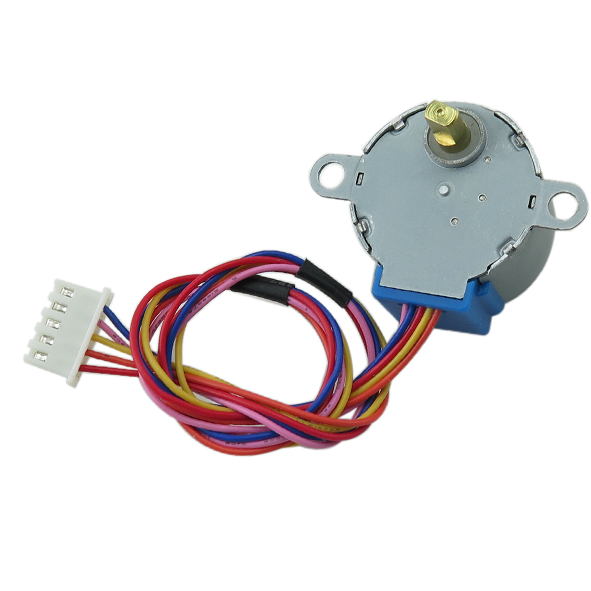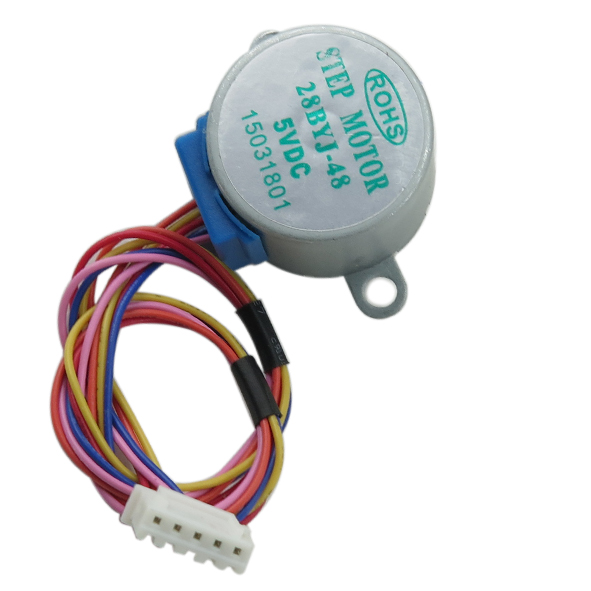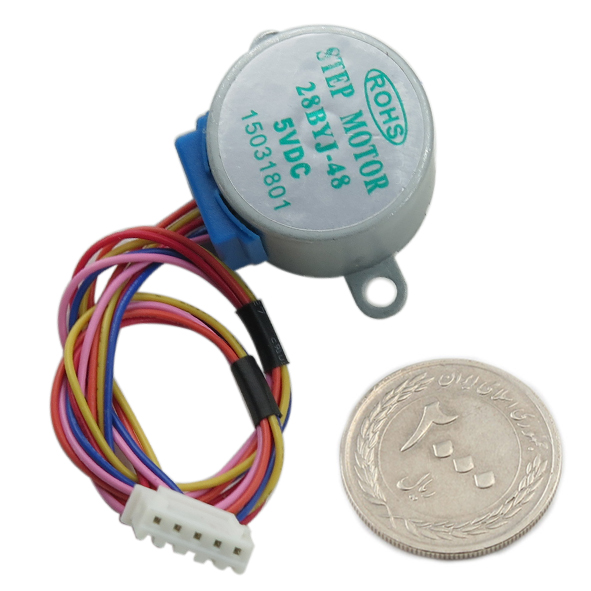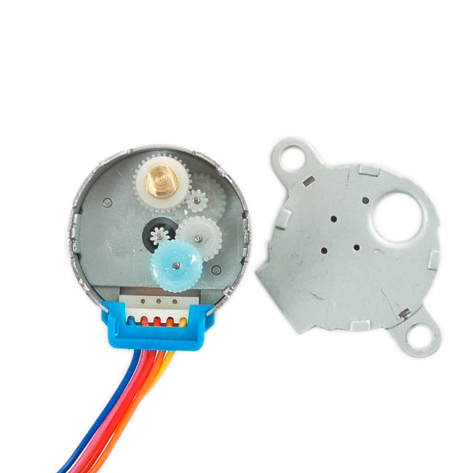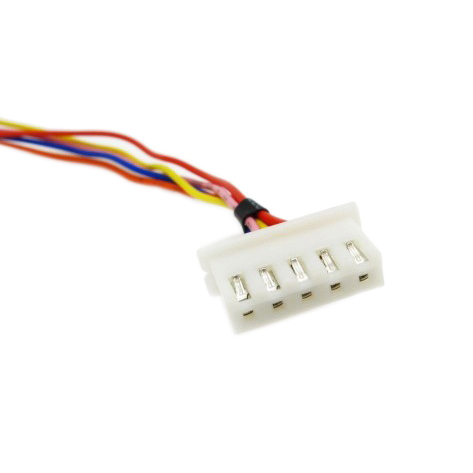68,330 تومان
در حال حاضر موجود نمی باشد
موجودی در حال ارسال به انبار
-
80 عدد6 روز پیش
علاقه مندان : 12 نفر
وضعیت : فعال
تعداد مرجوعی : 0
دنبال کنندگان : 15 نفر
قدمت : 12 سال و 4 ماه و 3 روز
وزن : 38 گرم
کل فروش : 2941 عدد
تعداد سفارش ها : 962 سفارش
4 از 5.0 با 12 رای
استپر موتور 5 ولت Stepper motor 28BYJ48
موتور پلهای از موتورهای بدون جاروبک است که کاربرد اصلی این موتور در
کنترل موقعیت و سرعت به صورت حلقهباز می باشد. این نوع موتور ها یک دور
کامل ( ۳۶۰ درجه ) را به تعدادی پله یا استپ مساوی تقسیم می نماید.
وقتی
ولتاژ به ترمینال موتورهای DC اعمال میگردد، به نرمی شروع به حرکت
میکنند. موتور پلهای با اِعمال پالسهای ورودی، در فواصل کوچک مشخص
میچرخد و هر پالس محور موتور را به اندازه ی زاویهای مشخص میچرخاند و اساساً دارای دندانههای مغناطیسی در اطراف یک شفت مرکزی از
جنس آهن میباشند. الکترومغناطیس ها بوسیله یک مدار راه انداز خارجی یا یک
میکروکنترلر تغذیه میگردند.
جهت چرخاندن شفت ابتدا به یکی از
مغناطیسها جریان داده میشود، که باعث جذب دندانههای دنده میگردد.
زمانیکه دندانه روبروی اولین مغناطیس میایستد، نسبت به مغناطیس بعدی دارای
یک فاصله میباشد. این به معنای آن است که در صورت روشن شدن الکترومغناطیس
بعدی و خاموش شدن اولی دنده به آهستگی میچرخد تا دندانه روبروی مغناطیس
دوم قرار گیرد. هر یک از این چرخشها یک گام (استپ) نامیده میشود، تعداد
مشخصی از این گامها یک دور کامل موتور را تشکیل می دهند (دقت شود نسبت
تعداد گامها به دور موتور همواره یک عدد صحیح است) و به این ترتیب یک موتور
میتواند با زوایای مشخص بچرخد.
استپر موتور مدل 28BYJ-48 دارای ولتاژ 5
ولت بوده و از 4 فاز بهره می برد. این استپر موتور یک نوع موتور الکتریکی
با عملکرد بسیار دقیق است که می توانید با استفاده از آن در یک زاویه دقیق
با تلرانس ثابت شافت، موتور را مدیریت نمائید. نرخ تغییر سرعت این محصول 1
به 64 است و برای کاربرد های رباتیک نیز مورد استفاده قرار می گیرد.
کاربرد استپر موتور 5 ولتی 28BYJ48:
- رباتیک
- اتوماسیون
- تجهیزات و آلات صنعتی
مشخصات استپر موتور 5 ولتی 28BYJ48:
- مدل: 28BYJ-48
- ولتاژ: 5 ولت DC
- تعداد فاز: 4
- نرخ تغییرات سرعت: 1/64
- زاویه گام: 5.625° /64
- فرکانس: 100 هرتز
- مقاومت دی سی: 50 اهم با تلرانس 7 درصد در دمای 25 درجه سانتی گراد
- فرکانس درون کششی دور آرام: > 600Hz
- فرکانس بیرون کششی دور آرام: > 1000Hz
- گشتاور درون کششی: بیش از 34.3 میلی نیوتن.متر
- گشتاور اصطکاکی: 600-1200 gf.cm
- گشتاور توقف: 300 gf.cm
- مقاومت عایق دار: >10MΩ(500V)
- درجه عایق کاری: A
- افزایش دما:
- نویز:
مستندات:
Array
Description:
A stepper motor, also known as a step
motor or stepping motor, is a brushless DC electric motor that divides a
full rotation into a number of equal steps. The motor's position can
then be commanded to move and hold at one of these steps without any
position sensor for feedback (an open-loop controller), as long as the
motor is carefully sized to the application with respect to torque and
speed.
There are three main types of stepper motors: Permanent magnet stepper, Variable reluctance stepper, Hybrid synchronous stepper.
One
of the first things to consider is the work that the motor has to do.
As you might expect, larger motors are capable of delivering more power.
Stepper motors come in sizes ranging from smaller than a peanut to big
NEMA 57 monsters.
Unipolar drivers, always energize the phases in the
same way. One lead, the "common" lead, will always be negative. The
other lead will always be positive. Unipolar drivers can be implemented
with simple transistor circuitry. The disadvantage is that there is less
available torque because only half of the coils can be energized at a
time.
Bipolar drivers use H-bridge circuitry to actually reverse the
current flow through the phases. By energizing the phases with
alternating the polarity, all the coils can be put to work turning the
motor.
Stepper motor performance is strongly dependent on the driver
circuit. Torque curves may be extended to greater speeds if the stator
poles can be reversed more quickly, the limiting factor being a
combination of the winding inductance. To overcome the inductance and
switch the windings quickly, one must increase the drive voltage. This
leads further to the necessity of limiting the current that these high
voltages may otherwise induce.
Another thing to consider is how the
motor will interface with the rest of the drive system. Motors are
available with a number of shaft styles: Round or "D" Shaft, Geared
shaft and Leadscrew Shaft.
Computer-controlled stepper motors are a
type of motion-control positioning system. They are typically digitally
controlled as part of an open-loop system for use in holding or
positioning applications.
In the field of lasers and optics, they are
frequently used in precision positioning equipment such as linear
actuators, linear stages, rotation stages, goniometers, and mirror
mounts. Other uses are in packaging machinery and positioning of valve
pilot stages for fluid control systems.
Commercially, stepper motors
are used in floppy disk drives, flatbed scanners, computer printers,
plotters, slot machines, image scanners, compact disc drives,
intelligent lighting, camera lenses, CNC machines and, more recently, in
3D printers.
Feature:
Model: 28BYJ-48
Rated Voltage: 5V DC
Number of Phase: 4
Speed Variation Ratio: 1/64
Stride Angle: 5.625° /64
Frequency: 100Hz
DC Resistance: 50Ω±7%(25℃)
Idle In-traction Frequency: > 600Hz
Idle Out-traction Frequency: > 1000Hz
In-traction Torque: > 34.3mN.m(120Hz)
Self-positioning Torque: > 34.3 mN.m
Friction Torque: 600-1200 gf.cm
Pull in Torque: 300 gf.cm
Insulated Resistance: >10MΩ(500V)
Insulated Electricity Power:600VAC/1mA/1s
Insulation Grade:A
Rise in Temperature:
Noise:
